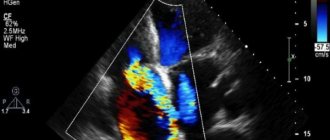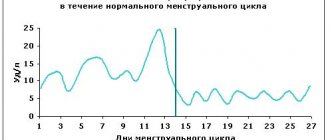0
Author of the article: Marina Dmitrievna
2017.07.27
165
Diagnostics
One of the mandatory diagnostics that you need to undergo during pregnancy is an ECG. The reason for the examination is hormonal imbalance, which can negatively affect the heart health of the expectant mother. Is it possible to do an ECG during pregnancy and is it harmful? First things first.
Why is an ECG performed during pregnancy?
An ECG of a child during pregnancy is the only method by which to actually diagnose the functionality of the heart muscle in expectant mothers, since they complain of:
- Shortness of breath.
- Cardiopalmus.
- Fatigue quickly.
- Painful sensations in the chest.
Shortness of breath during pregnancy
Already during the first months of pregnancy in women, cardiac output increases, peripheral edema appears and the jugular vein pulsates strongly. Only an ECG during pregnancy will help to understand the real cause of pain in the heart area and distinguish them from the following ailments:
- Muscle spasm.
- Gastroesophageal reflux.
- Pneumonia.
- Compression of the esophagus.
- Gastritis.
- Panic attack, etc.
Carrying out the procedure and its safety
The procedure for recording an electrocardiogram is absolutely safe and painless
, therefore it can be safely performed even on pregnant women and small children. The study is carried out for all pregnant women without exception upon registration, as well as for any complaints and changes in indicators of the cardiovascular system.
During a regular ECG study, 12 graphs are depicted on paper film, which display the direction of passage of the electrical impulse through the heart. In order to set these directions, special metal plates - electrodes - are applied to the skin of the wrists and shins, and electrodes are also attached to the chest in the area of the projection of the heart with suction cups.
Leads used in conventional ECG examination
:
- 3 standard leads (I, II, III);
- I – between the left and right hands;
- II – between the left leg and right arm;
- III – between the left leg and left arm.
- 3 enhanced limb leads (aVR, aVL, aVF);
- aVR – enhanced abduction from the right hand;
- aVL—increased abduction from the left arm;
- aVF - increased abduction from the left leg.
- 6 chest leads (V1, V2, V3, V4, V5, V6).
If necessary, a cardiologist can prescribe an ECG recording using additional leads
:
- According to Neb (registration of potential between points on the surface of the chest);
- V7 – V9 (continuation of standard chest leads);
- V3R - V6R (mirror reflection of chest leads V3 - V6 on the right half of the chest).
Such a large number of leads is necessary to clarify the localization of the pathological process in the heart. So the first 6 leads (standard and reinforced from the limbs) show the electrical potential of the heart in the frontal plane and allow us to determine the electrical axis of the heart, that is, its position. With various diseases, it changes, and the heart takes a horizontal or vertical position. Chest leads reflect the passage of an electrical impulse in the horizontal plane; with their help, the location of the affected area of the heart muscle is clarified.
Preparation for the procedure
Before the test, you need to rest for 10 to 15 minutes so that your heart rate returns to its normal level. Also, it is advisable that at least two hours pass after eating, but you should not take an ECG on an empty stomach, as this may affect the result of the analysis.
An ECG recording is usually carried out in a lying position so that the subject can relax as much as possible. To attach the electrodes, you need to undress from top to waist and bare your ankles (take off your socks or tights). The areas of skin on which the metal plates are attached are wiped with alcohol to degrease the surface and improve impulse conduction. A red electrode is attached to the right hand, a yellow electrode to the left hand, a green electrode to the left leg, and a black electrode to the right leg (it is necessary to ground the current in the event of a breakdown of the device). Recording cardiac activity takes only a few minutes. Then the resulting film is signed and sent to the doctor for decoding.
Is it possible for pregnant women to have an ECG often?
According to the standard, the study is done only once when the patient is registered at the antenatal clinic. But if complaints appear, or the doctor suspects the presence of cardiac pathologies, the pregnant woman is urgently sent for an ECG.
Reasons why you need to do a repeat heart examination:
- Sudden changes in blood pressure.
- Fainting and dizziness.
- Dull pain in left chest.
- Increased heart rate.
- Problem breathing.
- Prolonged toxicosis.
Dizziness during pregnancy
You can do a cardiogram at any period of pregnancy and not worry that it is dangerous for mother and child.
How is an ecg done during pregnancy?
Electrocardiography is a study of the electrical activity of the heart, which is performed through the chest over a period of time using electrodes that are placed on the surface of the skin. The recording is made using an external device and is called an electrocardiogram.
An electrocardiographic study is recommended to be carried out routinely for all pregnant women when registering a woman for timely detection of interruptions in the functioning of the heart. Also, an ECG will promptly warn about the development of gestosis. If deviations from the norm are detected, the woman should consult a cardiologist for advice.
This study is very important in the presence of conduction and rhythm disturbances, the causes of which are organic damage to the myocardium or drug intoxication. This study does not pose any danger to either the woman or the child, since nothing affects the body from the outside during this procedure, and the device simply records the electrical potentials of the heart.
During a normal pregnancy, there will be no significant changes on the ECG. But some changes may be present. They are caused by a hyperkinetic type of blood circulation and displacement of the diaphragm and heart in the chest cavity. During pregnancy, the heart gradually rotates around the sagittal axis counterclockwise. To give an idea of the rotation of the heart, it should be said that the axis gets its name from the Latin word “sagitta” (arrow) and has a direction from front to back. On an ECG in healthy women during pregnancy, the rhythm will be correct, sinus; sometimes extrasystoles or short periods of supraventricular tachycardia are possible.
During childbirth, heart rhythm disturbances may also occur:
- Atrial and ventricular extrasystole,
- atrial rhythm,
- Sinus and atrial tachycardia,
- Pacemaker migration,
- Incomplete and complete atrioventricular block.
- Sinus bradycardia (heart rate 60 or less per minute),
- Coronary sinus rhythm,
- Sinoauricular block.
During pregnancy, every woman should have an ECG done for the health of the unborn child. If heart problems are detected, the doctor will prescribe appropriate treatment, without which the intrauterine development of the fetus may be disrupted and the child will be born weakened with various pathologies.
Based on materials from girafejournal.com
The heart, being a vital organ of every person, must be constantly under control, since its work is a fundamental factor in the general condition of a person. The heart muscle makes about 100 thousand contractions during the day. Multiply it yourself: 60 minutes x 24 hours x 70 beats per minute = 100800! Therefore, understanding the importance of the heart, people once created a device that could help monitor its health. With the help of an ECG, high-quality monitoring of its work is carried out. What does this abbreviation represent?
ECG, or electrocardiography, is a method that determines the electrical activity of the heart and then records it on film (paper). This method is used to determine the quality of our heart. An electrocardiograph is a device that records the total difference between the potentials of the cells that make up the heart, calculated between certain two points, or in a specific lead, and then records the result on paper.
The resulting electrocardiogram is carefully studied by a doctor, and the following indicators
:
• An indicator of the speed of electrical impulse transmission by heart tissue;
This means that when studying an ECG, it is possible to timely determine various disorders in the heart: arrhythmias, dysfunction of the heart muscle and blockade.
What happens during pregnancy?
When pregnancy occurs, a woman’s body begins hormonal changes - this has a significant impact on the functioning of the entire cardiovascular system, and the heart receives a significant increase in load due to increased blood volume. An ECG allows you to identify and treat if abnormalities in the functioning of the heart muscle are detected, as well as prevent possible complications.
An ECG allows you to determine the heart rhythm of a pregnant woman and its character, possible conduction disturbances, and also assess the possibilities of adaptation to the constantly increasing needs of the body.
Features of the procedure
This procedure is safe and painless, which is why it is performed on young children and pregnant women. It is prescribed during the registration of a pregnant woman, as well as in case of changes in heart function and complaints.
During the procedure, 12 graphs are displayed on a paper tape, reflecting the direction of movement of the electrical impulse through the heart. To do this, electrodes are placed on the skin of the legs and wrists - these are metal plates, and electrodes are attached to the chest, where the heart area is located, using suction cups.
There are three leads that are used during a regular ECG examination, as well as three enhanced leads. Their number depends on the presence of pathology in the heart - in this case, additional leads help determine the exact location of the pathological process.
Let's take a closer look at the process of this procedure. It consists of the following stages.
— Preliminary rest for 10-15 minutes returns the heart rate to normal. Eating should be at least 2 hours before the procedure.
— ECG recording is carried out in a horizontal position - this is how the greatest relaxation occurs.
- You need to undress to the waist and also bare your ankles.
— The places where the electrodes will be attached are lubricated with alcohol to degrease and better conduct the impulse.
— A red electrode is attached to the right hand, a yellow one to the left, a green one to the left leg, and a black one to the right leg. The black electrode provides grounding for the device.
— Cardiac activity is recorded within a few minutes.
— Next, the resulting recording is sent to a specialist for decoding.
Main ECG indicators during pregnancy
— The normal rhythm of the heart muscle is sinus, the number of heart contractions is from 60 to 80 beats per minute.
- During pregnancy, single extrasystoles may occur - this means that excitation occurs in a different part of the heart, not in the area of the sinus node. This condition requires correction.
— The coincidence of the electrical axis of the heart (EOS for short) with the anatomical one is the norm for a healthy person and is EOS from 300 to 700. Since during pregnancy the volume of constantly circulating blood increases, the position of the heart may change to horizontal. In this case, EOS ranges from 700 to 900. These indicators are not considered a pathology; after childbirth, everything returns to normal.
We talked about ECG during pregnancy, how they do it, what the normal readings are. Carrying out this type of examination, as mentioned above, is mandatory at the beginning of pregnancy, because with its help you can promptly identify and begin treatment for changes in the activity of the heart, and this will be the key to your health, a successful birth and the health of your baby.
Based on materials from www.rasteniya-lecarstvennie.ru
Post published: 06-02-2013
An electrocardiogram is quite an important procedure for a pregnant woman. Such an examination is usually carried out when the expectant mother is registered. However, it can recur due to medical reasons or due to complaints from the woman herself.
An ECG during pregnancy is done to assess the condition of the heart and identify interruptions in its functioning. If a woman has any abnormalities, she needs to be monitored by a cardiologist.
During the normal course of pregnancy, as a rule, no significant changes are detected. Of course, there may be slight changes in blood circulation or a slight displacement of the heart. What on the electrocardiogram will look like deformation of the teeth and a shift to the left side of the electrical cardiac axis.
Typically, a healthy woman in the position has a sinus heart rate, but short attacks of extrasystoles, tachycardia and, in rare cases, ectopic rhythms can also occur. Changes in the body's hormonal levels can affect the time of intra-atrial, ventricular-atrial and intraventricular conduction.
In early pregnancy, a slight increase in the duration of the Q-T and P-Q intervals is detected. At the same time, the indicators do not exceed the norm, and with increasing gestational age they will gradually decrease. During childbirth, especially during pushing and contractions, the width of the P wave, the QRS complex and the duration of the P-Q interval decrease, and the cardiac electrical axis deviates to the right.
Also, during childbirth, a disturbance in the heart rhythm is observed; conditions such as sinus and atrial tachycardia, atrial rhythm, atrioventricular block, ventricular or atrial extrasystole and others may occur. In addition to disturbances in heart rhythm, sinoauricular block, sinus bradycardia, Parkinson's syndrome, and coronary sinus rhythm may occur during labor.
Carrying out a modern ECG during pregnancy is an effective method for identifying unwanted pathologies in pregnant women and the key to a successful birth.
Based on materials from journal-dlja-zhenshhin.ru
Content:
A woman expecting the birth of a baby must undergo an ECG test at least twice during the entire period of her pregnancy. Electrocardiography is a procedure during which a cardiogram of the heart is taken in both the woman and the fetus. It is carried out using electrodes that are attached to the skin. The examination shows the degree of heart activity, which is recorded on paper: heart rate and rhythm, speed of impulse conduction.
Using an ECG, the electrical activity of the heart is determined. If a woman does not have any special abnormalities, then a cardiogram is performed upon registration and before going on maternity leave.
This analysis is carried out to determine the functioning of the heart and identify possible abnormalities in it. If the examination reveals any pathologies, the woman should be observed by a cardiologist. The most common heart pathologies: arrhythmia of various types, blockade or anomalies that are related to the functions of the heart muscle.
The ECG procedure is mandatory for every expectant mother in order to register her with the LCD, as well as for the timely detection of abnormalities in the functioning of the heart. Using an electrocardiographic examination, the risk of gestosis can be detected and measures can be taken to treat it. Preeclampsia is a disorder of the functions of organs and systems in the body, which can cause a difficult pregnancy. If the study reveals negative changes, the pregnant woman will need the help of a cardiologist.
If the pregnancy is proceeding normally, then electrocardiography will confirm this without detecting any special abnormalities in the functioning of the heart. But this does not yet indicate that they do not exist at all. This is usually due to displacement of the heart and diaphragm in the chest area. It should be noted that during pregnancy, the heart can move around the sagittal axis (from the word - arrow), in the direction of movement. If the expectant mother is truly healthy, then the ELC data will be positive - sinus.
- Registration of a woman in the housing complex (registration). At the time of registration, a pregnant woman must undergo a huge number of different tests that will show the general state of her health and how ready she is for her new function - bearing a fetus.
- If a pregnant woman suffers from constant surges in blood pressure (high, low), she may also be prescribed an unscheduled ECG.
- A feeling of pain in the left side of the chest (in the area of the heart) is also an indicator for an ECG.
- Frequent dizziness and unexpected fainting.
- Any pathology during pregnancy is also a reason for frequent ECGs: high or low water levels, gestosis and toxicosis in severe forms.
If a woman has been scheduled for an unscheduled ECG procedure, there is no need to panic. The study poses absolutely no threat to either her or the baby.
Manipulations during an ECG are completely painless. Electrocardiography is done for pregnant women in the same way as for non-pregnant women. There are no special differences in the procedure. The output electrocardiographic tape contains 12 graphs, which indicate all the information about the different directions of the electrical impulses of the heart. Special plates are attached to the wrists and shins, and suction cups with electrodes are attached to the heart area.
- Go to the cardiologist's office well-rested, trying not to climb high stairs. Fatigue and physical exertion during the examination can affect its readings with a negative cardiogram result.
- 2 hours before the examination you need to eat; by the time of the procedure the stomach will no longer be full, but there will also not be a strong feeling of hunger, since this can also affect the final indicators of the cardiogram.
- The ECG is performed in a supine position. This position helps the patient relax as much as possible, and the heart will work as usual without straining. A woman must remove her clothes to the waist and expose her ankles. Electrodes are installed in the free places from clothing, which record the work of the heart.
Electrocardiography is considered a harmless diagnostic method. This procedure does not affect the human body in any way, since this study does not involve any manipulation of tissues or organs. The woman's electric field is recorded, which comes from the heart. An electrocardiographic study can be performed repeatedly, regardless of any period of time.
Therefore, there are no contraindications for electrocardiographic examination. An ECG can be performed on both pregnant women and small children, including seriously ill patients. ECG does not affect human milk in any way. If a woman does not feel entirely confident before giving birth and is worried about this, it will be very useful for her to read the article “How to get rid of prenatal depression.”
The cardiogram is deciphered only by a cardiologist. The woman herself is unlikely to be able to understand anything in its intricacies. However, understanding the basics of the curve is not only possible, but also necessary.
- The very first thing to do when trying to decipher it is to study the frequency and characteristics of the heartbeat. The normal heart rate is approximately 60-80 beats/minute with the correct rhythm.
- It often happens that the state of pregnancy affects the body in such a way that it provokes excitation in the atrium. If this is a common occurrence, additional examinations, tests, and then a course of treatment for the pregnant woman will be required.
- If the heart rate is below 60 beats/minute, then this is a clear sign of bradycardia; if it is above 90 beats/minute, then this is tachycardia.
Fetal electrocardiography is called CHT. As a rule, it is carried out in the last months of pregnancy and before the birth itself. But it can be prescribed in the early stages if it is necessary to study the condition of the unborn child. Using CHT, the baby’s heart rate, its movements, and, as the due date approaches, are measured, the frequency of contractions. The study is completely safe for both the pregnant woman and her child.
Video: Studies during pregnancy.
Based on materials from nedeli-beremennosti.com
Features of ECG of pregnant women
When analyzing diagnostic data, specialists take into account the physiological characteristics of the patient. For example: carrying a child provokes an increase in heart rate. This is explained by the fact that the pressure on the heart gradually increases, and it needs to process a lot of blood. In parallel with this, the heart rate should not be more than 80 r./min.
During pregnancy, extrasystole may appear - additional heart contractions. This is due to the fact that during pregnancy, excitation manifests itself not only in the sinus angle, but throughout the heart. If the expectant mother has systematically detected atrial or ventricular contraction, she will be prescribed additional examination.
In case of a poor ECG during pregnancy, the patient requires re-diagnosis. If the results are repeated, the woman is prescribed ultrasound diagnostics of the heart, which can identify the cause of the failure and select the optimal therapy.
Introduction
Electrocardiography (ECG, cardiogram) is an examination method that can help detect problems with the electrical activity of the heart.
Electrocardiography is performed on a pregnant woman to assess the functioning of the heart under conditions of increasing stress on the body.
During pregnancy, an ECG is recorded for:
- checking the electrical activity of the heart;
- searching for the causes of symptoms of cardiovascular diseases in pregnant women;
- checking the condition of the heart if the expectant mother has other diseases and complications of pregnancy.
During the entire period of bearing a child, every pregnant woman undergoes this test at least once. It is mandatory to record a cardiogram in the third trimester. This is a completely safe examination with no contraindications. A pregnant woman who has any diseases affecting the cardiovascular system needs to undergo this test several times during the entire period of bearing a child - at least in each trimester, and more often if necessary.
Interpretation of examination results in pregnant women is carried out by therapists and cardiologists.
Decoding the results
The decryption of the received data should be carried out by a qualified specialist. The only thing a woman can see for herself is her heart rate. Normally, this figure varies between 60-80 rubles/min.
Important! Pregnant women are characterized by tachycardia and bradycardia, therefore, if the pulse is 100 beats per minute with normal blood pressure, the woman does not need to worry.
For some women, the normal heart rate is 110-130 r./min, so if you do not know your body well, there is no need to draw hasty conclusions from the cardiogram. In any case, if the ECG norm is violated, the pregnant woman is sent to a cardiologist, who will select her treatment, taking into account the individual characteristics and nature of the disease.
Why is it carried out?
A pregnant woman experiences severe stress on the body, which can negatively affect the functioning of the heart. Obtaining data on cardiac activity is very important in pregnancy. It is important to do an ECG during pregnancy; this will reveal the following data:
- Quality of heart rhythm (frequency, character).
- The appearance of signs of ischemic damage to myocarditis.
- Determination of various abnormalities of any nature in the functioning of the heart, for example, inflammatory processes. After identifying abnormalities, the pregnant woman is sent for a consultation with a cardiologist, who takes measures to solve the problem; additional research must be done.
- The effect on the heart of drugs that were prescribed to restore heart function.
- Electrolyte imbalance.
- Obtaining information about arthritis, impulse blockade.
In addition, an abnormal ECG during pregnancy may indicate disorders caused by the severity of the disease, for example, with gestosis. If before pregnancy a woman suffered from any disturbances in the functioning of the heart, then it is necessary to carefully monitor her health, since a heavy load can negatively affect the well-being of the pregnancy.
ECG of the unborn child
An ECG of the fetus during pregnancy is called cardiotocography. This diagnostic shows the following data:
- Baby's heart rate.
- Movement of the fetus in the womb.
- Regularity of uterine contractions (if an ECG for pregnant women is performed shortly before birth).
The procedure is completely safe and does not cause discomfort to mother and child. To carry it out, sensors are placed on the woman’s stomach, which record the required information for forty minutes. Decryption is carried out immediately by a specialist.
Indicators that cardiotocography measures:
- Pulse. Normally – within 110-170 beats/min. If minor deviations up or down are recorded, this indicates minor violations. Indicators below 100 or more than 180 are considered a dangerous symptom.
- Heart rate variability or pulse indicators in a calm and active state of the baby. The difference between these figures is within 10-25 rubles/min. Violations of 5 strokes in both directions are not considered a dangerous symptom. But if a baby’s heart rate in a calm and active state differs by only 5 beats, this indicates serious problems.
- The child's reaction to external movements, music or stimulation. If your baby's heart rate increases, then everything is fine.
The above criteria give doctors the opportunity to understand the child’s condition and the correctness of his development. Cardiotocography, together with other diagnostics, helps to identify fetal hypoxia, and in the worst case, influences the decision on artificial birth or caesarean section.
The study is prescribed only after the 32nd week of pregnancy. Previously, it is not carried out, since the fetus has not yet fully formed reactions to external stimuli.
Fetal ECG
Preparing for an ECG
No special preparation is required, as before performing other procedures or taking tests. General recommendations before doing an electrocardiogram: rest, calm down, have a little snack. Let us explain why in order to successfully conduct an ECG, the stated conditions must be met.
The state of fatigue, tiredness as a result of physical or emotional stress affects the condition of the heart muscle. As a result, the readings on the ECG film may be inaccurate or poor.
The study should be carried out on a full stomach. At the same time, it is important not to overeat, but also not to feel hungry, since all this also affects the results of electrocardiography.
Indications for an ECG during pregnancy are:
- registration for pregnancy management;
- dizziness, lightheadedness, fainting;
- blood pressure surges (episodes of decreased/increased pressure);
- The patient complains of pain, heaviness in the heart area;
- severe pregnancy (polyhydramnios, oligohydramnios, severe toxicosis, gestosis, etc.).
During a normal pregnancy, an ECG is done once, when a woman is registered.
Repeated studies are carried out as prescribed by a doctor if signs of cardiovascular diseases (cardiovascular diseases) are detected or if the patient has any complaints about the heart.
The ECG procedure during pregnancy is performed similarly to a standard study of the condition and functionality of the heart. Does not cause painful or uncomfortable sensations. It does not have a negative effect on the woman’s body and the process of fetal development.
When entering the doctor's office for an electrocardiogram, you need to undress to the waist, take off your tights (stockings) or roll up your trouser legs so that your ankles are exposed. Lie on your back. In the lying position, the body completely relaxes, there is no load on the heart, the heart muscle works in a calm mode.
Plates with suction cups and electrodes are installed on the wrists, shins, and upper chest in the area of the heart projection, which read the rhythm of the heartbeat. The skin is degreased with alcohol to ensure the unimpeded passage of impulses through soft tissue to the device’s sensors.
Multi-colored electrodes are attached to the limbs, which are necessary for conducting low-frequency pulses through the body and grounding the current in case of equipment malfunction. Red is glued to the right hand, yellow to the left. The green electrode is attached to the shin of the left leg, the black one to the right.
The heart test does not involve any radiation. ECG is a completely safe procedure with no contraindications.
The cardiogram is recorded for several minutes. The finished ECG film is given to the doctor observing the pregnancy.
If abnormalities are detected on the ECG, consultation with a cardiologist is necessary. The patient undergoes re-examination. If cardiovascular disease is suspected, an electrocardiogram during pregnancy is done with additional leads. Based on the results of the study, a conclusion is drawn up on the further management of pregnancy and childbirth, and treatment is carried out in a cardiac clinic.
The body of a pregnant woman is subjected to a lot of stress, so it is understandable that the expectant mother is prescribed a lot of studies and tests. One of the mandatory ones is an ECG (electrocardiogram) of the heart. If the pregnancy proceeds without complications and the woman does not have chronic heart diseases, then an ECG is done 2 times: when registering with the antenatal clinic and at the beginning of the third trimester. Is the procedure dangerous for the health of mother and baby?
A pregnant woman frees the chest, wrist and ankle areas from clothing. Takes a horizontal position on a couch, previously covered with a disposable diaper.
The ECG device is:
- electrodes for capturing impulses of the body and heart;
- galvanometer, which amplifies and transmits signals;
- a recorder that displays the results in the form of graphs.
The electrodes are pre-disinfected and degreased with alcohol, attached to the ankles, wrist, chest area, where a special conductor gel is applied. Taking the readings takes a couple of minutes. The decoding is carried out by the doctor who performed the procedure or, if significant deviations dangerous to health are detected, by a cardiologist.
Features of ECG during pregnancy:
- To ensure accurate results, you should eat two hours before the procedure: stress on the gastrointestinal tract or hunger will definitely affect the results.
- Emotional state and physical activity can also cause the detection of tachycardia. The expectant mother should calm down, relax, and take a break after climbing the stairs or walking.
- You should not take sedatives before the procedure.
- It is worth giving up body cosmetics - greasy cream reduces the transmission of impulses, the readings may be inaccurate.
- To make undressing easier, you should choose suitable clothing. This is especially important for pregnant women, whose heart rate increases even with slight exertion.
Important! There is no radiation exposure during the ECG procedure. The device has no effect on the mother’s body or the fetus. The study is absolutely safe.
Indications for unscheduled ECG
- Frequent dizziness and fainting
- High or low blood pressure
- Pain in the sternum
- Detection of oligohydramnios or polyhydramnios during pregnancy
- Severe persistent toxicosis
An ECG can detect heart disease at an early stage. During pregnancy, the load on the heart muscle increases, and the functioning of all body systems changes. If heart pathology is detected, treatment is determined, and the cardiologist recommends an activity regimen for the pregnant woman.
Diseases that an electrocardiogram can diagnose:
- Arrhythmia
- Angina pectoris
- Tachycardia
- Aneurysm
- Myocarditis
In the last trimester of pregnancy, a fetal electrocardiogram (CTG) is prescribed to detect possible pathologies, prepare for their timely elimination, and provide postpartum care. The procedure occurs by placing devices on the mother's stomach. The child does not feel any discomfort. Video about the importance of CTG and its implementation here
Decoding the testimony
There is no need to understand the indicators of various analyzes, but curiosity takes over.
Doctors take into account the following ECG parameters:
- sinus rhythm;
- heart rate;
- source of excitation;
- conductivity;
- electric axis;
- teeth, segments and intervals.
Sinus rhythm reflects the rhythm of the heart. In the graph, this is expressed as a constant distance between the tallest teeth. The indicator is normal if the deviation is no more than 0.1.
Heart rate is the number of beats per minute. It is calculated using a formula based on the cardiogram readings and is indicated on the sheet. The norm is 60-80 beats per minute. A lower value is a sign of bradycardia, a higher value is a sign of tachycardia. For pregnant women, a slight increase in heart rate is considered normal, but it is carefully monitored by measuring blood pressure at every appointment with a gynecologist.
The source of excitation is normally the sinus node of the heart. When this function is taken over by another department, the work is changed, the doctor determines this from the P wave graph, and when detected, a corresponding note is made.
Conductivity is determined by the sequence of impulse transmission. This is reflected in the graphics by the constant order of the teeth.
The electrical axis is the angle of inclination of the heart. Normally it is from 50 to 70 degrees. If deviations to the right-left are more than 90 or -30 degrees, consultation with a cardiologist is necessary. If the difference from the norm is insignificant, there is no danger to health.
Jagged areas are areas of the graph located above the line. Intervals are sections located along a line. Segments are areas that include teeth and intervals. Watch the video on deciphering the cardiogram
The schedule indicator standards are as follows:
- QRS – 0.06 – 0.1 s;
- P – 0.07 – 0.11 s;
- Q – 0.03 s;
- T – 0.12 – 0.28 s;
- PQ – 0.12-0.20 s.
Important! In case of significant deviations from the norm and danger to health, the cardiologist is immediately notified. Do not worry about the results if there are no comments from the medical staff.
An ECG during pregnancy is a common and safe procedure. It is prescribed to everyone without exception, no need to worry. Diagnostics of the heart function of mother and child allows us to identify the problem at an early stage and cope with it without complications. The procedure is a graphic representation of impulses transmitted by the heart, without affecting the body. Is it possible to do an ECG during pregnancy? The answer is clear - it is necessary. Video about this method of studying heart function and its significance here
One of the mandatory procedures that a pregnant woman must undergo is an ECG. The reason for this need is hormonal changes in the body of the expectant mother, which often lead to changes in the functioning of the heart.
To promptly detect possible deviations and take corrective measures, electrocardiography is done.










